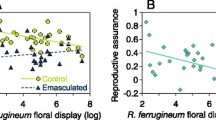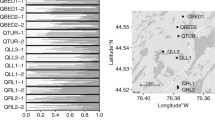Abstract
The mating systems of wild plant populations have profound effects on their genetic structure and evolution, yet remain unknown or incompletely described for many species. One such species, the herbaceous native annual Linum sulcatum Riddell (Linaceae), is thought to be self-compatible, but there has been no experimental evidence to date to support this claim. To assess the breeding system of this species, seeds were collected from wild populations and reared in a controlled environment. Floral manipulations and controlled pollinations were conducted to determine the degree of self-compatibility of this species and to distinguish between autonomous and facilitated modes of selfing. Additional controlled within- and between-population crosses were conducted to determine the relative degree to which this species can outcross. This study showed that self-fertilization was highly successful and can occur autonomously. In contrast, outcrossing success, both within and between populations, was very limited, suggesting this species may exhibit an extreme degree of cross-incompatibility. A pollen tube growth experiment showed that self-pollination resulted in the formation of more pollen tubes relative to cross-pollination and that complete pollen tube growth can occur less than 2 h following self-pollination. This information is relevant to the future persistence of this species, as much of its remaining habitat is distributed among small, highly fragmented patches subjected to current and future environmental stressors.






Similar content being viewed by others
References
Armbruster WS, Pérez-Barrales R, Arroyo J, Edwards ME, Vargas P (2006) Three-dimensional reciprocity of floral morphs in wild flax (Linum suffruticosum): a new twist on heterostyly. New Phytol 171:581–590
Barrett SC (2002) The evolution of plant sexual diversity. Nat Rev Genet 3:274–284
Barrett SC, Harder LD (2017) The ecology of mating and its evolutionary consequences in seed plants. Annu Rev Ecol Evol Syst 48:135–157
Barrett SC, Harder LD, Worley AC (1996) The comparative biology of pollination and mating in flowering plants. Philos Trans Biol Sci 351:1271–1280
Biale JB (1964) Growth, maturation, and senescence in fruits: recent knowledge on growth regulation and on biological oxidations has been applied to studies with fruits. Science 146:880–888
Bonnin I, Ronfort J, Wozniak F, Olivieri I (2001) Spatial effects and rare outcrossing events in Medicago truncatula (Fabaceae). Molec Ecol 10:1371–1383
Charlesworth D (2003) Effects of inbreeding on the genetic diversity of populations. Philos Trans R Soc Lond B Biol Sci 358:1051–1070
Charlesworth D (2006) Evolution of plant breeding systems. Curr Biol 16:R726–R735
Cheptou PO, Hargreaves AL, Bonte D, Jacquemyn H (2017) Adaptation to fragmentation: evolutionary dynamics driven by human influences. Philos Trans R Soc 372:20160037
Crnokrak P, Barrett SC (2002) Perspective: purging the genetic load: a review of the experimental evidence. Evolution 56:2347–2358
Cronk Q (2016) Plant extinctions take time. Science 353:446–447
Darwin C (1876) The effects of cross and self fertilisation in the vegetable kingdom. John Murray, London
Darwin C (1877) The different forms of flowers on plants of the same species. John Murray, London
Davis MB, Shaw RG (2001) Range shifts and adaptive responses to Quaternary climate change. Science 292:673–679
Dole JA (1990) Role of corolla abscission in delayed self-pollination of Mimulus guttatus (Scrophulariaceae). Am J Bot 77:1505–1507
Eckert CG, Kalisz S, Geber MA, Sargent R, Elle E, Cheptou PO, Goodwille C et al (2010) Plant mating systems in a changing world. Trends Ecol Evol 25:35–43
Edmands S (1999) Heterosis and outbreeding depression in interpopulation crosses spanning a wide range of divergence. Evolution 53:1757–1768
Etterson JR, Mazer SJ (2016) How climate change affects plants’ sex lives. Science 353:32–33
Etterson JR, Keller SR, Galloway LF (2007) Epistatic and cytonuclear interactions govern outbreeding depression in the autotetraploid Campanulastrum americanum. Evolution 61:2671–2683
Fenster CB, Galloway LF (2000) Inbreeding and outbreeding depression in natural populations of Chamaecrista fasciculata (Fabaceae). Conserv Biol 14:1406–1412
Fisher RA (1941) Average excess and average effect of a gene substitution. Ann Eugen 11:53–63
Franklin-Tong VE (2008) Self-incompatibility in flowering plants: evolution, diversity, and mechanisms. Springer, New York
Fuentes M, Schupp EW (1998) Empty seeds reduce seed predation by birds in Juniperus osteosperma. Evol Ecol 12:823–827
Galen C (2000) High and dry: drought stress, sex-allocation trade-offs, and selection on flower size in the alpine wildflower Polemonium viscosum (Polemoniaceae). Am Nat 156:72–83
Glémin S, Bazin E, Charlesworth D (2006) Impact of mating systems on patterns of sequence polymorphism in flowering plants. Proc R Soc Lond B Biol Sci 273:3011–3019
Goldberg EE, Kohn JR, Lande R, Robertson KA, Smith SA, Igić B (2010) Species selection maintains self-incompatibility. Science 330:493–495
Goodwillie C, Weber J (2018) The best of both worlds? A review of delayed selfing in flowering plants. Am J Bot 105:641–655
Goodwillie C, Kalisz S, Eckert CG (2005) The evolutionary enigma of mixed mating systems in plants: occurrence, theoretical explanations, and empirical evidence. Ann Rev Ecol Evol Syst 36:47–79
Grossenbacher D, Briscoe Runquist R, Goldberg EE, Brandvain Y (2015) Geographic range size is predicted by plant mating system. Ecol Lett 18:706–713
Hamrick JL, Godt MW (1996) Effects of life history traits on genetic diversity in plant species. Phil Trans R Soc Lond B Biol Sci 351:1291–1298
Harris BD (1968) Chromosome numbers and evolution in North American species of Linum. Am J Bot 55:1197–1204
Igic B, Busch JW (2013) Is self-fertilization an evolutionary dead end? New Phytol 198:386–397
Kalisz S, Vogler DW (2003) Benefits of autonomous selfing under unpredictable pollinator environments. Ecology 84:2928–2942
JMP®, Pro, Version 10, SAS Institute Inc., Cary, 1989–2012
Kalisz S, Vogler D, Fails B, Finer M, Shepard E, Herman T, Gonzales R (1999) The mechanism of delayed selfing in Collinsia verna (Scrophulariaceae). Am J Bot 86:1239–1247
Kalisz SD, Vogler DW, Hanley KM (2004) Context-dependent autonomous self-fertilization yields reproductive assurance and mixed mating. Nature 430:884
Kearns CA, Inouye DW (1994) Fly pollination of Linum lewisii (Linaceae). Am J Bot 81:1091–1095
Keller LF, Waller DM (2002) Inbreeding effects in wild populations. Trends Ecol Evol 17:230–241
Klips RA, Snow AA (1997) Delayed autonomous self-pollination in Hibiscus laevis (Malvaceae). Am J Bot 84:48–53
Kramer AT, Havens K (2009) Plant conservation genetics in a changing world. Trends Plant Sci 14:599–607
Kuhn M (1867) Einige Bemerkungen über Vandellia und den Blüten dimorphismus. Bot Zeitung 25:65–67
Leimu R, Vergeer P, Angeloni F, Ouborg N (2010) Habitat fragmentation, climate change, and inbreeding in plants. Ann N Y Acad Sci 1195:84–98
Lloyd DG (1992) Self- and cross-fertilization in plants. II. The selection of self-fertilization. Int J Plant Sci 153:370–380
Lloyd DG, Schoen DJ (1992) Self-and cross-fertilization in plants. I. Functional dimensions. Int J Plant Sci 153:358–369
Lord EM (1981) Cleistogamy: a tool for the study of floral morphogenesis, function and evolution. Bot Rev 47:421–449
Mazer SJ, Hove AA, Miller BS, Barbet-Massin M (2010) The joint evolution of mating system and pollen performance: predictions regarding male gametophytic evolution in selfers vs. outcrossers. Perspect Plant Ecol Evol Syst 12:31–41
McDill J, Repplinger M, Simpson BB, Kadereit JW (2009) The phylogeny of Linum and Linaceae subfamily Linoideae, with implications for their systematics, biogeography, and evolution of heterostyly. Syst Bot 34:386–405
Müller H (1883) The fertilisation of flowers. Macmillan, London
Nasrallah JB (2017) Plant mating systems: self-incompatibility and evolutionary transitions to self-fertility in the mustard family. Curr Opin Genet Dev 47:54–60
Noël E, Chemtob Y, Janicke T, Sarda V, Pélissié B, Jarne P, David P (2016) Reduced mate availability leads to evolution of self-fertilization and purging of inbreeding depression in a hermaphrodite. Evolution 70:625–640
Ornduff R (1969) Reproductive biology in relation to systematics. Taxon 1:121–133
Petry WK, Soule JD, Iler AM, Chicas-Mosier A, Inouye DW, Miller TE, Mooney KA (2016) Sex-specific responses to climate change in plants alter population sex ratio and performance. Science 353:69–71
Qu R, Li X, Luo Y, Dong M, Xu H, Chen X, Dafni A (2007) Wind-dragged corolla enhances self-pollination: a new mechanism of delayed self-pollination. Ann Bot 100:1155–1164
Rathcke B, Jules E (1993) Habitat fragmentation and plant-pollinator interactions. Curr Sci 65:273–277
Richards AJ (1997) Plant breeding systems. Garland Science, New York
Roels SAB, Kelly JK (2011) Rapid evolution caused by pollinator loss in Mimulus guttatus. Evolution 65:2541–2552
Rogers CM (1963) Yellow flowered species of Linum in eastern North America. Brittonia 15:97–122
Rogers CM (1969) Relationships of the North American species of Linum (flax). Bull Torrey Bot Club 96:176–190
Rogers CM, Xavier KS (1972) Parallel evolution in pollen structure in Linum. Grana 12:41–46
Samson F, Knopf F (1994) Prairie conservation in North America. Bioscience 44:418–421
Schoen DJ, Brown A (1991) Intraspecific variation in population gene diversity and effective population size correlates with the mating system in plants. Proc Natl Acad Sci 88:4494–4497
Schoen DJ, Lloyd DG (1992) Self-and cross-fertilization in plants. III. Methods for studying modes and functional aspects of self-fertilization. Int J Plant Sci 153:381–393
Shaw RG, Etterson JR (2012) Rapid climate change and the rate of adaptation: insight from experimental quantitative genetics. New Phytol 195:752–765
Spira TP, Snow AA, Whigham DF, Leak J (1992) Flower visitation, pollen deposition, and pollen-tube competition in Hibiscus moscheutos (Malvaceae). Am J Bot 79:428–433
Stebbins GL (1950) Variation and evolution in plants. Geoffrey Cumberlege, London
Stebbins GL (1970) Adaptive radiation of reproductive characteristics in angiosperms, I: pollination mechanisms. Annu Rev Ecol Syst 1:307–326
Sun SG, Guo YH, Gituru RW, Huang SQ (2005) Corolla wilting facilitates delayed autonomous self-pollination in Pedicularis dunniana (Orobanchaceae). Plant Syst Evol 251:229–237
Traveset A (1993) Deceptive fruits reduce seed predation by insects in Pistacia terebinthus L. (Anacardiaceae). Evol Ecol 7:357–361
Vogler DW, Kalisz S (2001) Sex among the flowers: the distribution of plant mating systems. Evolution 55:202–204
Vogler DW, Das C, Stephenson AG (1998) Phenotypic plasticity in the expression of self-incompatibility in Campanula rapunculoides. Heredity 81:546–555
Williams JH (2012) Pollen tube growth rates and the diversification of flowering plant reproductive cycles. Int J Plant Sci 173:649–661
Winn AA, Elle E, Kalisz S, Cheptou PO, Eckert CG, Goodwillie C, Johnston MO et al (2011) Analysis of inbreeding depression in mixed-mating plants provides evidence for selective interference and stable mixed mating. Evolution 65:3339–3359
Wright SI, Kalisz S, Slotte T (2013) Evolutionary consequences of self-fertilization in plants. Proc R Soc B 280:20130133
Young A, Boyle T, Brown T (1996) The population genetic consequences of habitat fragmentation for plants. Trends Ecol Evol 11:413–418
Zaremba RE (2003) Linum sulcatum Riddell grooved flax. New England plant conservation program
Acknowledgements
The authors thank Andrew Olufson for assistance with pollen tube staining, Bryan Bandli for assistance with confocal microscopy, and Sonja Smerud for assistance with the map. This work was supported by the National Science Foundation grant DEB-1142784 to JRE.
Author information
Authors and Affiliations
Corresponding author
Electronic supplementary material
Below is the link to the electronic supplementary material.
Rights and permissions
About this article
Cite this article
Jahnke, M.R., Etterson, J.R. Autonomous self-fertilization in Linum sulcatum, a native annual with a previously unknown mating system. J Plant Res 132, 57–67 (2019). https://doi.org/10.1007/s10265-018-1076-z
Received:
Accepted:
Published:
Issue Date:
DOI: https://doi.org/10.1007/s10265-018-1076-z




